Astronomy Picture of the Day 2011 每日天文一图第五季 ...
来源:百度文库 编辑:超级军网 时间:2024/04/29 11:35:32
每日天文一图第一季[点我]
每日天文一图第二季[点我]
每日天文一图第三季[点我]
每日天文一图第四季[点我]
内容来自NASA网站,中译文现改用台湾成功大学版本,因常用译名及文法有所不同,本人会略作修改
本帖仅供浏览,请勿回复,谢谢合作
2011 January 1
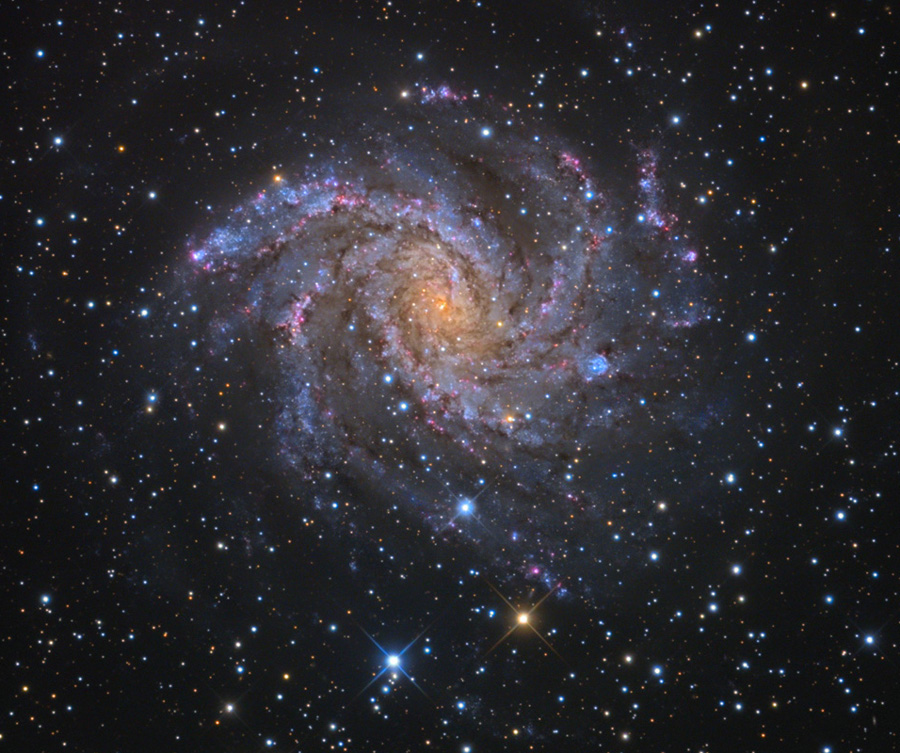
Fireworks Galaxy NGC 6946
Image Credit &Copyright: Adam Block,Mt. Lemmon SkyCenter,U. Arizona
Explanation: Celebrate the New Year with the Fireworks Galaxy!Also known as NGC 6946, the big, beautifulspiral galaxyis located just 10 million light-years away, behind a veil offoreground dust and stars in the high and far-offconstellation of Cepheus.From our vantage point in theMilky Way Galaxy, we seeNGC 6946face-on.In thiscolorfulcosmic portrait,the galaxy's colors changefrom the yellowish light of old stars in the core to young blue starclusters and reddish star forming regions along the loose, fragmentedspiral arms.NGC 6946 is bright in infrared lightand rich in gas and dust,exhibiting a furious rate of star formation.Nearly 40,000 light-years across, the nearby spiral isfittingly referred to as theFireworks Galaxy.Over the last 100 years, at least nine supernovae, thedeath explosionsof massive stars, werediscovered in NGC 6946.By comparison, the average rate for supernovae in the Milky Wayis about 1 per century.
每日天文一图第一季[点我]
每日天文一图第二季[点我]
每日天文一图第三季[点我]
每日天文一图第四季[点我]
内容来自NASA网站,中译文现改用台湾成功大学版本,因常用译名及文法有所不同,本人会略作修改
本帖仅供浏览,请勿回复,谢谢合作
2011 January 1

Fireworks Galaxy NGC 6946
Image Credit &Copyright: Adam Block,Mt. Lemmon SkyCenter,U. Arizona
Explanation: Celebrate the New Year with the Fireworks Galaxy!Also known as NGC 6946, the big, beautifulspiral galaxyis located just 10 million light-years away, behind a veil offoreground dust and stars in the high and far-offconstellation of Cepheus.From our vantage point in theMilky Way Galaxy, we seeNGC 6946face-on.In thiscolorfulcosmic portrait,the galaxy's colors changefrom the yellowish light of old stars in the core to young blue starclusters and reddish star forming regions along the loose, fragmentedspiral arms.NGC 6946 is bright in infrared lightand rich in gas and dust,exhibiting a furious rate of star formation.Nearly 40,000 light-years across, the nearby spiral isfittingly referred to as theFireworks Galaxy.Over the last 100 years, at least nine supernovae, thedeath explosionsof massive stars, werediscovered in NGC 6946.By comparison, the average rate for supernovae in the Milky Wayis about 1 per century.
新年的烟花,NGC6946烟火星系{:cha:}
今天允许我们插队 期待着你的大作
我把你以前的帖子地址放上 可以不?
這個我喜歡.無垠的宇宙
2011 January 2

Looking Back at an Eclipsed Earth
Credit: Mir 27 Crew; Copyright: CNES
Explanation: Here is what the Earth looks like during asolar eclipse.Theshadowof theMoon can be seen darkening part ofEarth.This shadow movedacross theEarth at nearly 2000 kilometers per hour.Only observers near the center of thedark circle see a total solar eclipse -others see a partial eclipse where only part of theSun appears blocked by the Moon.This spectacular picture of the 1999 August 11solar eclipsewas one of the last evertaken from the Mir spacestation.The two bright spots that appear on the upper left are thought to beJupiter and Saturn.Mir was deorbited in acontrolled re-entry in 2001.

Looking Back at an Eclipsed Earth
Credit: Mir 27 Crew; Copyright: CNES
Explanation: Here is what the Earth looks like during asolar eclipse.Theshadowof theMoon can be seen darkening part ofEarth.This shadow movedacross theEarth at nearly 2000 kilometers per hour.Only observers near the center of thedark circle see a total solar eclipse -others see a partial eclipse where only part of theSun appears blocked by the Moon.This spectacular picture of the 1999 August 11solar eclipsewas one of the last evertaken from the Mir spacestation.The two bright spots that appear on the upper left are thought to beJupiter and Saturn.Mir was deorbited in acontrolled re-entry in 2001.
2011 January 3
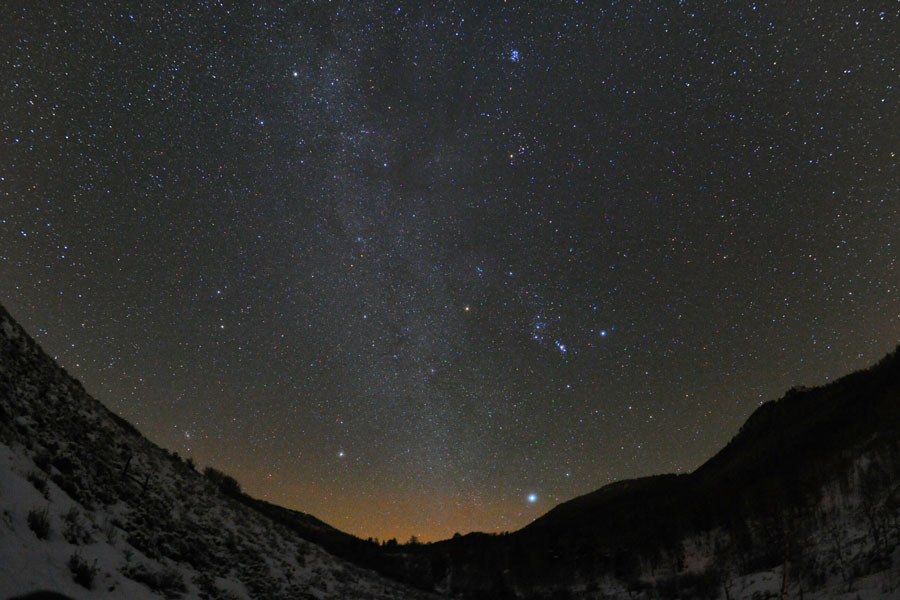
Winter Hexagon Over Stagecoach Colorado
Credit & Copyright: Jimmy Westlake(Colorado Mountain College)
Explanation: If you can find Orion, you might be able to find the Winter Hexagon. The Winter Hexagon involves some of thebrightest stars visible,together forming a large and easily foundpattern in thewinter sky ofEarth'snorthern hemisphere. The stars involved can usually be identified even in thebright night skies of abig city, although here they appear over darkerStagecoach,Colorado, USA.. The six stars that compose theWinter Hexagon areAldebaren,Capella,Castor (andPollux),Procyon,Rigel, andSirius. Here, the band of our Milky Way Galaxy runs through the center of theWinter Hexagon, while thePleiades openstar cluster is visible just above.The Winter Hexagonasterism engulfs several constellations including much of theiconic steppingstoneOrion.

Winter Hexagon Over Stagecoach Colorado
Credit & Copyright: Jimmy Westlake(Colorado Mountain College)
Explanation: If you can find Orion, you might be able to find the Winter Hexagon. The Winter Hexagon involves some of thebrightest stars visible,together forming a large and easily foundpattern in thewinter sky ofEarth'snorthern hemisphere. The stars involved can usually be identified even in thebright night skies of abig city, although here they appear over darkerStagecoach,Colorado, USA.. The six stars that compose theWinter Hexagon areAldebaren,Capella,Castor (andPollux),Procyon,Rigel, andSirius. Here, the band of our Milky Way Galaxy runs through the center of theWinter Hexagon, while thePleiades openstar cluster is visible just above.The Winter Hexagonasterism engulfs several constellations including much of theiconic steppingstoneOrion.
为毛是方言?? 普通话版的难道不更新了?
scott 发表于 2011-1-4 09:39 
等北京天文馆上班吧...

等北京天文馆上班吧...
棱镜一样的缘故。
支持,美图
bjnr 发表于 2011-1-1 18:24 
已经编辑到主楼了啊~

已经编辑到主楼了啊~
2011 January 6
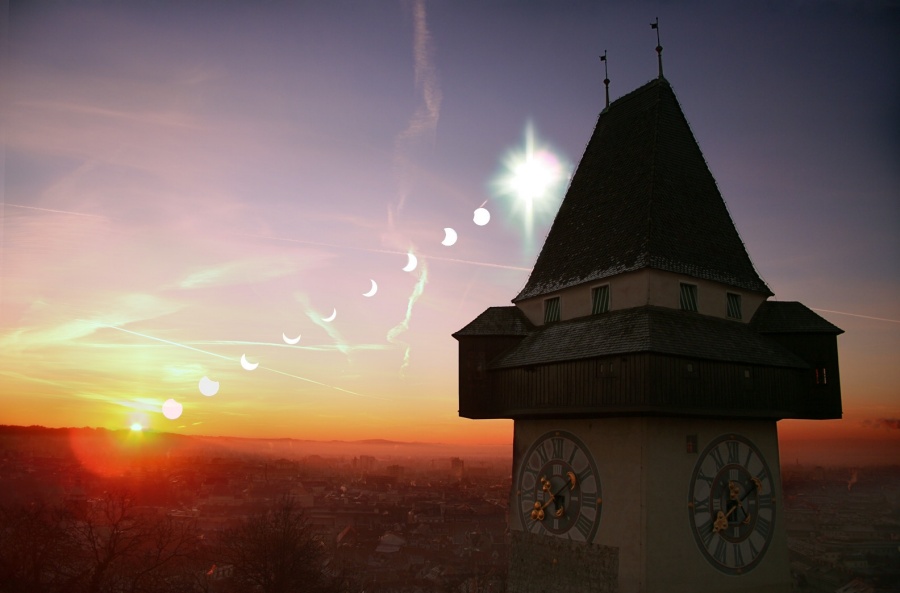
Sunrise, Moonrise
Image Credit &Copyright: Robert Pölzl
Explanation: For many Europeans, the Sun and New Moon rose togetheron January 4 in apartial solar eclipse.Arriving close on the heels of the new year,it was the first of a series of four(!) partial solareclipsesdue in 2011.This composite image documentsthe gracefulcelestial event in colorfulmorning skies over Graz, Austria.Beginning before sunrise, frames were taken to record the positionand progress of the eclipse every 15 minutes.As Sun and Moon rose abovethe eastern horizon, the town ofGraz is seen bathed in warming sunlight only partially blocked bythe New Moon, spreading beneath the town's landmark clock tower.

Sunrise, Moonrise
Image Credit &Copyright: Robert Pölzl
Explanation: For many Europeans, the Sun and New Moon rose togetheron January 4 in apartial solar eclipse.Arriving close on the heels of the new year,it was the first of a series of four(!) partial solareclipsesdue in 2011.This composite image documentsthe gracefulcelestial event in colorfulmorning skies over Graz, Austria.Beginning before sunrise, frames were taken to record the positionand progress of the eclipse every 15 minutes.As Sun and Moon rose abovethe eastern horizon, the town ofGraz is seen bathed in warming sunlight only partially blocked bythe New Moon, spreading beneath the town's landmark clock tower.
 支持支持美图
支持支持美图除了太阳和月球,天空中还有工业废气和飞机云迹。
2011 January 8

NGC 7293: The Helix Nebula
Image Credit &Copyright: Ed Henry(Hay Creek Observatory)
Explanation: A mere seven hundred light years from Earth, in the constellationAquarius,a sun-like star is dying.Its last few thousand years have produced theHelixNebula(NGC 7293), a well studied and nearby example of aPlanetaryNebula,typical of this final phase of stellar evolution. A total of 10 hours of exposuretime have gone in to creating thisremarkably deepview of the nebula.It shows details of the Helix's brighterinner region, about 3light-years across, but also follows fainterouter halofeatures that give the nebula a span of well over six light-years.The white dot at the Helix's center is this Planetary Nebula's hot,central star.A simple looking nebula at first glance, the Helixis now understood to have a surprisinglycomplex geometry.

NGC 7293: The Helix Nebula
Image Credit &Copyright: Ed Henry(Hay Creek Observatory)
Explanation: A mere seven hundred light years from Earth, in the constellationAquarius,a sun-like star is dying.Its last few thousand years have produced theHelixNebula(NGC 7293), a well studied and nearby example of aPlanetaryNebula,typical of this final phase of stellar evolution. A total of 10 hours of exposuretime have gone in to creating thisremarkably deepview of the nebula.It shows details of the Helix's brighterinner region, about 3light-years across, but also follows fainterouter halofeatures that give the nebula a span of well over six light-years.The white dot at the Helix's center is this Planetary Nebula's hot,central star.A simple looking nebula at first glance, the Helixis now understood to have a surprisinglycomplex geometry.
2011 January 9
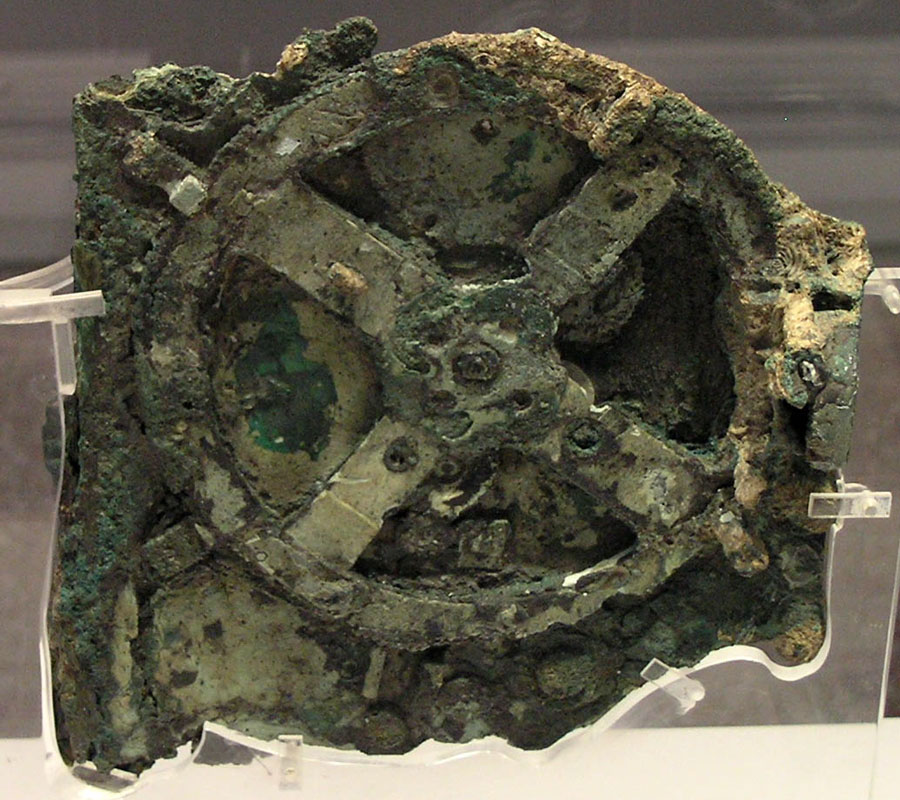
The Antikythera Mechanism
Credit & Copyright: Wikipedia
Explanation: What is it? It was found at the bottom of the sea aboard an ancient Greek ship. Its seeming complexity has prompted decades of study, although some of its functions remained unknown. Recent X-rays of the device have now confirmed the nature of the Antikythera mechanism, and discovered several surprising functions. The Antikythera mechanism has been discovered to be a mechanical computer of an accuracy thought impossible in 80 BC, when the ship that carried it sunk. Such sophisticated technology was not thought to be developed by humanity for another 1,000 years.Its wheels and gears create a portable orrery of the sky that predicted star and planet locations as well as lunar and solar eclipses.The Antikythera mechanism, shown above, is 33 centimeters high and similar in size to a large book.

The Antikythera Mechanism
Credit & Copyright: Wikipedia
Explanation: What is it? It was found at the bottom of the sea aboard an ancient Greek ship. Its seeming complexity has prompted decades of study, although some of its functions remained unknown. Recent X-rays of the device have now confirmed the nature of the Antikythera mechanism, and discovered several surprising functions. The Antikythera mechanism has been discovered to be a mechanical computer of an accuracy thought impossible in 80 BC, when the ship that carried it sunk. Such sophisticated technology was not thought to be developed by humanity for another 1,000 years.Its wheels and gears create a portable orrery of the sky that predicted star and planet locations as well as lunar and solar eclipses.The Antikythera mechanism, shown above, is 33 centimeters high and similar in size to a large book.
冰晶反射太阳光造成。
最近发生超新星地点附近也就不足为奇了。
光年远。
2011 January 13

NGC 3521 Close Up
Credit: Data -Hubble Legacy Archive,ESA, NASAProcessing -Robert Gendler
Explanation: Gorgeous spiral galaxy NGC 3521 is a mere 35 million light-yearsdistant, toward theconstellation Leo.Spanning some 50,000 light-years, its central region is shown inthis dramatic image,constructed from data drawn from theHubble Legacy Archive.The close-up view highlights this galaxy'scharacteristicmultiple, patchy, irregular spiral arms laced with dust andclusters of young, blue stars.In constrast, manyother spirals exhibit grand, sweeping arms.A relatively bright galaxy in planet Earth's sky,NGC 3521 iseasily visible in small telescopes, but often overlooked byamateur imagers in favor of other Leo spiral galaxies,like M66 and M65.

NGC 3521 Close Up
Credit: Data -Hubble Legacy Archive,ESA, NASAProcessing -Robert Gendler
Explanation: Gorgeous spiral galaxy NGC 3521 is a mere 35 million light-yearsdistant, toward theconstellation Leo.Spanning some 50,000 light-years, its central region is shown inthis dramatic image,constructed from data drawn from theHubble Legacy Archive.The close-up view highlights this galaxy'scharacteristicmultiple, patchy, irregular spiral arms laced with dust andclusters of young, blue stars.In constrast, manyother spirals exhibit grand, sweeping arms.A relatively bright galaxy in planet Earth's sky,NGC 3521 iseasily visible in small telescopes, but often overlooked byamateur imagers in favor of other Leo spiral galaxies,like M66 and M65.
2011 January 14

Quadrantids over Qumis
Image Credit &Copyright: Babak Tafreshi(TWAN)
Explanation: The Quadrantid Meteor Showeris an annual event for planet Earth'snorthern hemisphere skygazers.It usually peaks briefly in the cold, early morning hours of January 4.The shower is named for itsradiant point on the sky within theold, astronomically obsolete constellationQuadransMuralis.That position is situated near the boundaries of the modernconstellations Hercules, Bootes, and Draco.In this haunting time exposure,two quadrantid meteor streaks are capturedcrossing trailsleft by rising starsof the constellations Virgo and Corvus, but Saturnleaves the brightest "star" trail.The meteor streaks, one bright and one faint, are nearly parallelabove and right of center in the frame.Fittingly, the old cistern structure in the foreground liesabove the nowburied city of Qumis.Known as a city of many gates, Qumis (in Greek historyHecatompylos),was founded 2300 years ago in ancient Persia.
说明:对于北半球的天空观测者们来说,象限仪座流星雨也是一年一度的重要天文事件。通常流星雨的高峰期会出现在1月4日的凌晨时分。流星雨以其在天空中的辐射点位置命名--象限仪座。这个方位位于如今武仙座、牧夫座和天龙座的边缘附近。在这张印象深刻的延时影像中,两颗象限仪座流星轨迹划过了室女座和乌鸦座内的恒星留下的轨迹,但影像中最明亮的是土星的星迹。两道轨迹,一明一暗,平行于影像的中央右上方。恰好,影像前景中的废气的水塔位于早已被掩埋的Qumis城市的上方。作为一座“百门之城”,Qumis(在希腊历史上称为Hecatompylos)建于2300年前的古代波斯。
2011 January 14

Quadrantids over Qumis
Image Credit &Copyright: Babak Tafreshi(TWAN)
Explanation: The Quadrantid Meteor Showeris an annual event for planet Earth'snorthern hemisphere skygazers.It usually peaks briefly in the cold, early morning hours of January 4.The shower is named for itsradiant point on the sky within theold, astronomically obsolete constellationQuadransMuralis.That position is situated near the boundaries of the modernconstellations Hercules, Bootes, and Draco.In this haunting time exposure,two quadrantid meteor streaks are capturedcrossing trailsleft by rising starsof the constellations Virgo and Corvus, but Saturnleaves the brightest "star" trail.The meteor streaks, one bright and one faint, are nearly parallelabove and right of center in the frame.Fittingly, the old cistern structure in the foreground liesabove the nowburied city of Qumis.Known as a city of many gates, Qumis (in Greek historyHecatompylos),was founded 2300 years ago in ancient Persia.
说明:对于北半球的天空观测者们来说,象限仪座流星雨也是一年一度的重要天文事件。通常流星雨的高峰期会出现在1月4日的凌晨时分。流星雨以其在天空中的辐射点位置命名--象限仪座。这个方位位于如今武仙座、牧夫座和天龙座的边缘附近。在这张印象深刻的延时影像中,两颗象限仪座流星轨迹划过了室女座和乌鸦座内的恒星留下的轨迹,但影像中最明亮的是土星的星迹。两道轨迹,一明一暗,平行于影像的中央右上方。恰好,影像前景中的废气的水塔位于早已被掩埋的Qumis城市的上方。作为一座“百门之城”,Qumis(在希腊历史上称为Hecatompylos)建于2300年前的古代波斯。
呵呵 25 加 25 木有人明白啊
2011 January 15
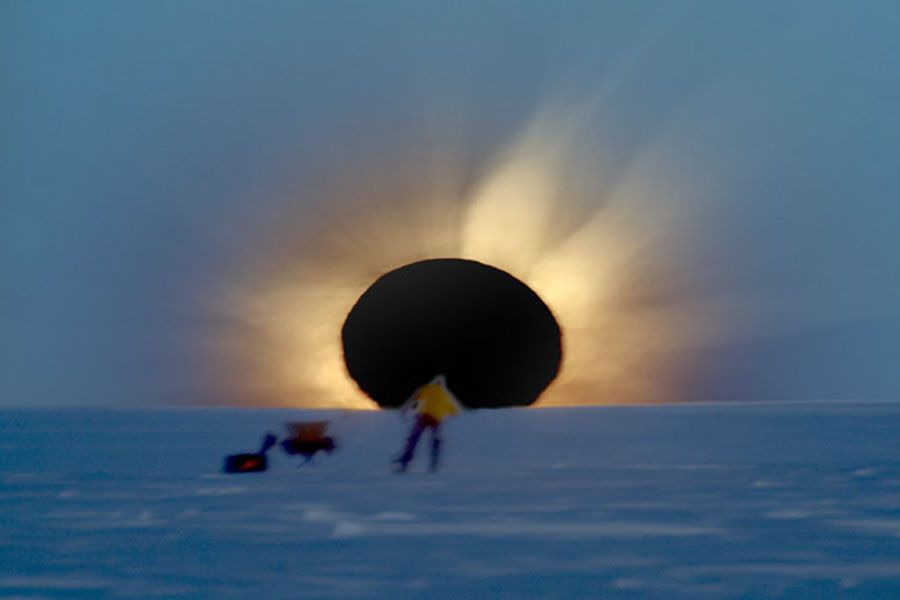
A Total Eclipse at the End of the World
Credit & Copyright: Fred Bruenjes(moonglow.net)
Explanation: Would you go to the end of the world to see a total eclipse of the Sun?If you did, would you be surprised to find someone else there already?In 2003, the Sun, the Moon, Antarctica, and two photographers all lined up inAntarctica during an unusualtotal solar eclipse. Even given the extreme location, a group ofenthusiastic eclipse chasers ventured near thebottom of the world toexperience the surreal momentarydisappearance of the Sun behind the Moon. One of the treasures collected was theabove picture -- a composite of four separate imagesdigitally combined to realistically simulate how the adaptive humaneye saw the eclipse. As the image was taken, both theMoon and the Sunpeaked together over an Antarctic ridge. In thesudden darkness, themagnificent coronaof the Sun became visible around the Moon. Quite by accident, another photographer was caughtin one of the images checking his video camera. Visible to his left are an equipment bag and acollapsible chair.

A Total Eclipse at the End of the World
Credit & Copyright: Fred Bruenjes(moonglow.net)
Explanation: Would you go to the end of the world to see a total eclipse of the Sun?If you did, would you be surprised to find someone else there already?In 2003, the Sun, the Moon, Antarctica, and two photographers all lined up inAntarctica during an unusualtotal solar eclipse. Even given the extreme location, a group ofenthusiastic eclipse chasers ventured near thebottom of the world toexperience the surreal momentarydisappearance of the Sun behind the Moon. One of the treasures collected was theabove picture -- a composite of four separate imagesdigitally combined to realistically simulate how the adaptive humaneye saw the eclipse. As the image was taken, both theMoon and the Sunpeaked together over an Antarctic ridge. In thesudden darkness, themagnificent coronaof the Sun became visible around the Moon. Quite by accident, another photographer was caughtin one of the images checking his video camera. Visible to his left are an equipment bag and acollapsible chair.
2011 January 16
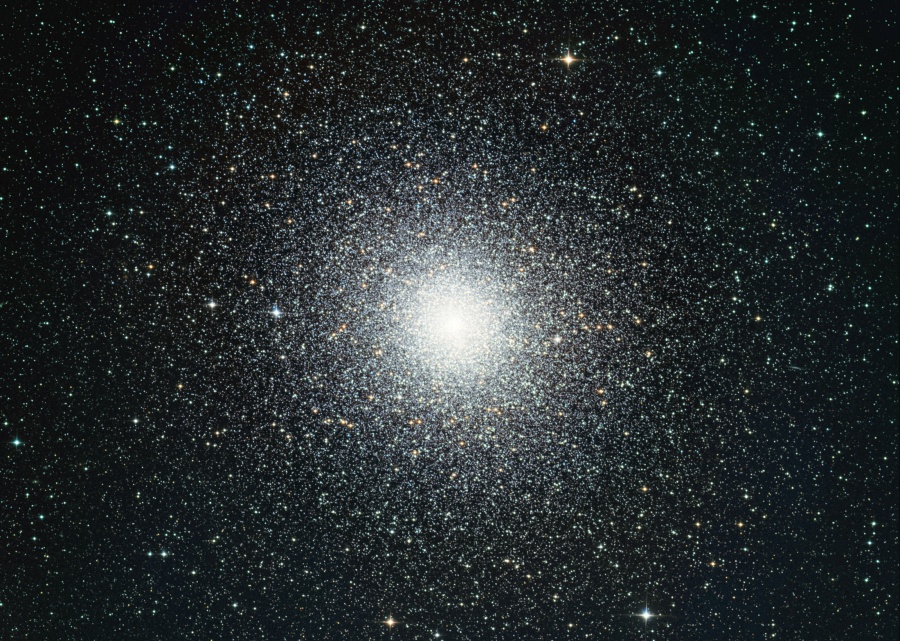
Globular Star Cluster 47 Tuc
Image Credit &Copyright: Dieter Willasch(Astro-Cabinet)
Explanation: Globular star cluster 47 Tucanae is a jewel of the southern sky.Also knownas NGC 104, it roamsthe halo of our Milky Way Galaxyalong with some 200 other globular star clusters.The second brightest globular cluster (afterOmega Centauri)as seen from planet Earth, it lies about 13,000 light-years away andcan be spotted naked-eye near theSmall Magellanic Cloudin the constellation ofthe Toucan.The dense cluster is made up of several millionstars in avolumeonly about 120 light-years across.Red giant starson the outskirts of the cluster are easy to pick out as yellowish stars inthis sharptelescopic portrait.Globular cluster 47 Tuc is also home to exoticx-ray binary star systems.

Globular Star Cluster 47 Tuc
Image Credit &Copyright: Dieter Willasch(Astro-Cabinet)
Explanation: Globular star cluster 47 Tucanae is a jewel of the southern sky.Also knownas NGC 104, it roamsthe halo of our Milky Way Galaxyalong with some 200 other globular star clusters.The second brightest globular cluster (afterOmega Centauri)as seen from planet Earth, it lies about 13,000 light-years away andcan be spotted naked-eye near theSmall Magellanic Cloudin the constellation ofthe Toucan.The dense cluster is made up of several millionstars in avolumeonly about 120 light-years across.Red giant starson the outskirts of the cluster are easy to pick out as yellowish stars inthis sharptelescopic portrait.Globular cluster 47 Tuc is also home to exoticx-ray binary star systems.
海王庙。在精心策划下,经过数个镜头转换以及专业的数码处理最终在去年的最后两天完成了这张影像。
中央的黑洞。这是多么美妙的空间利用啊!
太空影像,并且在土星的南半球上投下了宽带阴影。
我们银河系规模的两倍多。(陈昌)
度。
2011 January 22

Polar Ring Galaxy NGC 660
Image Credit &Copyright: Stephen Leshin
Explanation: NGC 660 lies near the center ofthisintriguing skyscape,swimming in the boundaries of the constellationPisces.Over 20 million light-years away, its peculiar appearance marks it asa polar ring galaxy.A rare galaxy type, polar ring galaxies have a substantial populationof stars, gas, and dustorbiting in rings nearly perpendicularto the plane of the galactic disk.The bizarreconfiguration could have been caused by the chance captureof material from a passing galaxy by the disk galaxy, with the captureddebris strung out in a rotating ring.The polarring component can be usedto explore the shape of the galaxy's otherwise unseendark matterhalo by calculating thedark matter's gravitationalinfluence on the rotation of the ring and disk.Broader than the disk, NGC 660's ring spans about 40,000 light-years.

Polar Ring Galaxy NGC 660
Image Credit &Copyright: Stephen Leshin
Explanation: NGC 660 lies near the center ofthisintriguing skyscape,swimming in the boundaries of the constellationPisces.Over 20 million light-years away, its peculiar appearance marks it asa polar ring galaxy.A rare galaxy type, polar ring galaxies have a substantial populationof stars, gas, and dustorbiting in rings nearly perpendicularto the plane of the galactic disk.The bizarreconfiguration could have been caused by the chance captureof material from a passing galaxy by the disk galaxy, with the captureddebris strung out in a rotating ring.The polarring component can be usedto explore the shape of the galaxy's otherwise unseendark matterhalo by calculating thedark matter's gravitationalinfluence on the rotation of the ring and disk.Broader than the disk, NGC 660's ring spans about 40,000 light-years.
今日为视频,墙内用户似乎无法观看,暂停...
年采回表面样本返回地球。
超新星,最初爆发发出的光为何没有地球上的文字记载?
附近较小星系的引力作用而造成。
光年。
月份卫星重返大气层前检测该卫星。(陈昌)
2011 January 29

Opportunity at Santa Maria Crater
Credit: MarsExploration Rover Mission,NASA,JPL,Cornell;Image Processing: Marco Di Lorenzo,Kenneth Kremer
Explanation: Celebrating 7 yearson the surface ofthe Red Planet,Mars exploration rover Opportunity now stands near therim of 90 meter wideSantaMaria crater.Remarkably, Opportunity and its fellowrover Spirit were initiallyintended for a 3 monthlong primary mission.Still exploring, the golf cart-sized robot and shadow (far right)appear in the foreground of this panoramic view of itscurrent location.The mosaic was constructed using images from the rover's navigationcamera.On its7 year anniversary,Opportunity can boast traversing a total of 26.7 kilometersalongthe martian surface.After investigating Santa Maria crater, controllers plan to haveOpportunity resume a long-term trek toward Endurance crater,a large, 22 kilometer diameter crater about 6 kilometers fromSanta Maria.During coming days, communication with the rover will be moredifficult as Mars moves close to alignment with the Sun as seenfrom planet Earth'sperspective.

Opportunity at Santa Maria Crater
Credit: MarsExploration Rover Mission,NASA,JPL,Cornell;Image Processing: Marco Di Lorenzo,Kenneth Kremer
Explanation: Celebrating 7 yearson the surface ofthe Red Planet,Mars exploration rover Opportunity now stands near therim of 90 meter wideSantaMaria crater.Remarkably, Opportunity and its fellowrover Spirit were initiallyintended for a 3 monthlong primary mission.Still exploring, the golf cart-sized robot and shadow (far right)appear in the foreground of this panoramic view of itscurrent location.The mosaic was constructed using images from the rover's navigationcamera.On its7 year anniversary,Opportunity can boast traversing a total of 26.7 kilometersalongthe martian surface.After investigating Santa Maria crater, controllers plan to haveOpportunity resume a long-term trek toward Endurance crater,a large, 22 kilometer diameter crater about 6 kilometers fromSanta Maria.During coming days, communication with the rover will be moredifficult as Mars moves close to alignment with the Sun as seenfrom planet Earth'sperspective.
小型机器人进入海洋搜寻生命迹象。
Astronomy Picture of the Day 2010-每日天文一图第四季
Astronomy Picture of the Day-2009-每日天文一图第三季 ...
Astronomy Picture of the Day 2011 每日天文一图第五季 ...
picture of the year!
Strongly sugest to prohibit all the picture of signa ...
test picture
only one picture
Super! J10 New Picture Series
New J-10 Picture
【天文学】天文第一书籍Astronomy - Principles and Pra ...
The destroyers of PRC
The Frigates of PRC